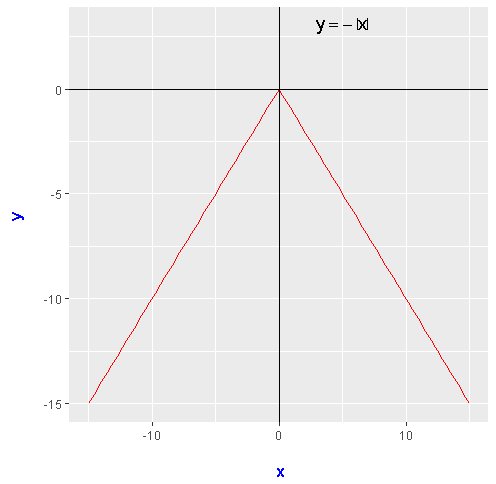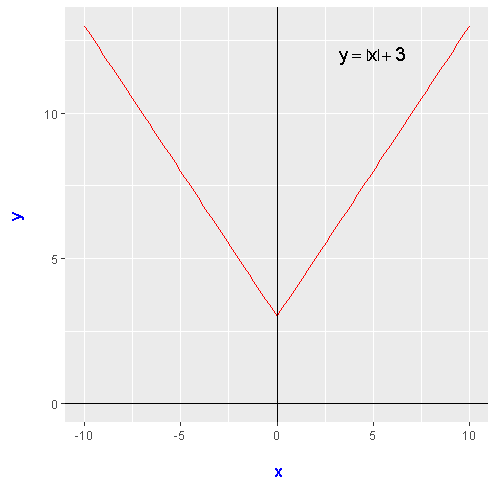Absolute Values: An Introduction
This article will be about absolute values. This topic is somewhat tricky for those new to this topic. The images below were produced from the statistical programming language R with the ggplot2 package.
The Absolute Value
The absolute value of a real number \(x\) is the non-negative part of \(x\). It is expressed as \(|x|\). Sometimes it is referred to the modulus and can be thought of as a distance from zero.
The simplest case of absolute values is with numbers. Here are some examples.
\[\displaystyle |3| = 3\]
\[\displaystyle |-3| = 3\]
\[\displaystyle |-120| = 120\]
\[\displaystyle - |120| = - 120\]
\[\displaystyle |0| = 0\]
\[\displaystyle |-1 \cdot 0| = |0| = 0\]
\[\displaystyle |(-2)^2 | = |4| =4\]
So far we have dealt with absolute value of numbers and not variables. We now generalize and present the formal definition.
\[\displaystyle |x| = \begin{cases}x & \text{if } x \geq 0 \\ -x & \text{if } x < 0 \end{cases}\]
Here is a visual of the absolute function centered at \(x = 0\).

The absolute function is an example of a piecewise function. This type of function depends on the value of \(x\). It is not like linear functions where it is a smooth line for all \(x\) values. If we had \(-|x|\) then the picture above would be upside down and would look like a hat.

We now consider intercepts with the \(x\) variable inside the absolute value. If we had \(|x - 7|\) then the origin point at (0,0) from \(|x|\) would be shifted to the right 7 units to the point (7, 0) for \(|x - 7|\). If we had \(|x + 2|\) then the origin point at (0,0) from \(|x|\) would be shifted to the left 2 units to the point (2, 0) for \(|x - 7|\). Refer to the pictures below as a visual aid.


Any vertical shifts would have numbers outside the absolute value function. For example, \(|x| + 3\) would shift the every point from \(|x|\) up by 3 units.

Domain and Range
For the absolute function \(|x|\), the domain is all real numbers for \(x\). The range for \(|x|\) is for all positive numbers and zero.
Properties
There are properties associated with the absolute value function. Here are a few.
\[\displaystyle |x| \geq 0\]
\[\displaystyle |x| = 0 \text{ if and only if (iff) } x = 0\]
\[\displaystyle |x \cdot y| = |x| \cdot |y|\]
\[\displaystyle |x + y| \leq |x| + |y| \hspace{0.5in} \text{ (Triangle Inequality)}\]
These two properties come in handy when dealing with inequalities. (The constant \(a\) is a real number.)
\[\displaystyle |x| \leq a \iff -a \leq x \leq a\]
\[\displaystyle |x| \geq a \iff x \geq a \text{ or } x \leq -a \]
For example if we have \(|x - 5| < 2\), we can solve for \(x\) as follows:
\[\displaystyle |x - 5| < 2\]
\[\displaystyle -2 < x - 5 < 2\]
\[\displaystyle -2 + 5 < x < 2 + 5\]
\[\displaystyle 3 < x < 7\]
Here is another example where we have \(|x - 1| \geq 3\). The second property is used.

\[\displaystyle |x - 1| \geq 3\]
\[\displaystyle (x - 1) \geq 3 \text{ or } (x - 1) \leq -3\]
\[\displaystyle x \geq 4 \text{ or } x \leq -2\]
Notes
There are more things that can be said about the absolute value of \(x\). The topic of absolute values and complex numbers are not mentioned here.